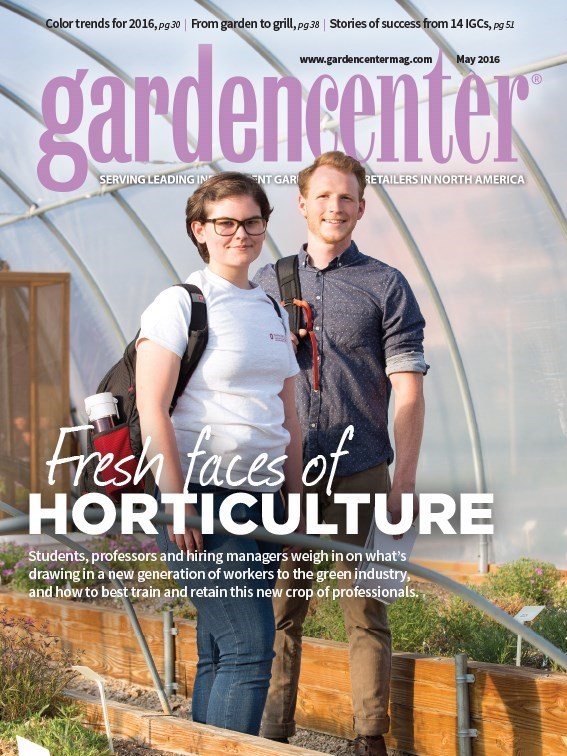The nineteenth century author and historian Alice Morse Earle wrote, “The fragrance of the sweetest rose is beyond any other flower scent, it is irresistible, enthralling; you cannot leave it. I have never doubted the rose has some compelling quality not shared by other flowers. I do not know whether it comes from some inherent witchery of the plant, but it certainly exists.”
Truer words were never spoken. Smell is one of our most powerful senses, and you witness the power of the fragrance of roses almost every day in your garden center. Customers can’t walk by roses without sticking their nose into the flowers and savoring the experience.
It wasn’t long ago that I often heard gardeners complain about newer roses lacking strong fragrance as well as disease resistance. Some of their complaints rang true. It seemed rose hybridizers were most concerned with creating long-stemmed, brightly colored, perfectly formed hybrid teas with long vase life. Fragrance, disease resistance and easy maintenance had taken a back seat.
Rose breeders must have also heard these complaints because things have changed dramatically. Not only do we have Knock Out roses and Flower Carpet landscape roses, but we also have newer fragrant roses like Elle, Falling in Love, Julia Child, and Grande Dame that stand side-by-side with classics like Double Delight, Mister Lincoln and Sutter’s Gold. And there are entire series of roses, such as the David Austin English Roses and Romantica Roses, in which fragrance is a key selling point. Indeed, fragrant roses have never been more popular.



Your nose knows
The chemistry of rose fragrance is complicated and involves hundreds of volatile oils and other compounds. The intensity and character of a specific rose variety depends on weather, and often, its genetic makeup.
The fragrance of a rose is usually strongest on warm, sunny days but can also be influenced by time of day, humidity, soil conditions and even the health of the plant. In general, fragrance is most powerful around midmorning. Although darker colored, more heavily petaled varieties are often associated with stronger fragrance, again, there are no hard, fast rules. Even roses on the same plant can smell different from one another. More generally, red and pink roses are most likely to have that “old rose fragrance,” whereas white and yellow roses usually smell of orris, nasturtium, violet or lemon. Varieties with orange shades usually have scents of fruit, orris, violet or clover.
Rose fragrances are usually described with seven basic scents: rose (or Damask), nasturtium, violet, orris (iris root), apple, lemon and clover, but that’s just the start. Other terms you’ll hear include tea leaves, cloves, raspberry, bay, parsley, wine, musk, fern, moss, hyacinth, orange, anise, marigold, banana, apricot, geranium, peppers, spice and melon.
Terms used to describe rose fragrance can often be traced to a variety’s genetic makeup or the specific fragrance of a type of old garden rose. For example, the heady aroma many people think of as “classic rose fragrance” (there is just no other way to describe it) or “old rose fragrance” is linked to Gallica roses and their hybrids, especially Damask roses. And, the not-what-you-expect, clove-like musk aroma is common in musk roses (Rosa moschata).

Individuals can interpret fragrances differently. For example, most people would react to a rose variety described as having a myrrh fragrance with words like anise or licorice. A few others might describe it as “mediciney” or even like “old socks.” Good luck trying to get any two people to agree on what orris smells like, but you’ll hear things like “powdery,” “earthy,” “violet-like” and even “dirty floral.”
Fragrant varieties
With all the vagaries about rose fragrance, you can still come up with varieties known for their specific aromas. Rose catalogs usually do a good job describing fragrance in their variety descriptions, but if you want the most bang for your buck, look for words like “powerful,” “strong,” “intoxicating,” “overpowering,” “rich” and the like. For more information on the roses and sources, go to helpmefind.com.
Why not use the power of fragrant roses to help sell plants and other products? Bring fragrant varieties front and center. Give customers an immersive experience and help them appreciate the complexity and beauty of rose fragrances. Encourage them to stick their noses in roses and describe what they smell. In the process, you’ll not only sell roses but also other rose care products, such as pruners, gloves, fertilizers and pest control products.


Explore the May 2016 Issue
Check out more from this issue and find your next story to read.
Latest from Garden Center
- GS1 US Celebrates 50-Year Barcode 'Scanniversary' and Heralds Next-Generation Barcode to Support Modern Commerce
- Weekend Reading 7/26/24
- Retail Revival: Making gardening contagious
- ‘Part of our story’
- Registration now open for Garden Center Fertile Ground Webinar Series
- Dramm introduces new hose, sprinkler attachments for home gardeners, nurseries
- Meet the 15 Retailers' Choice Awards winners from Cultivate'24
- 2024 Top 100 Independent Garden Centers List





